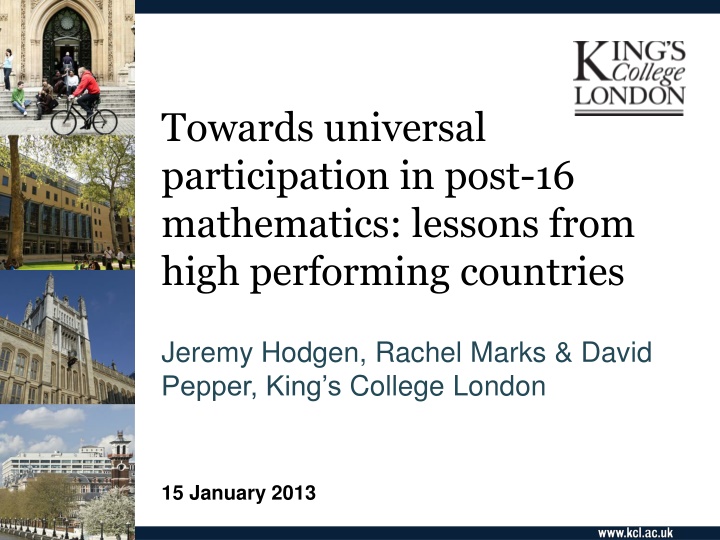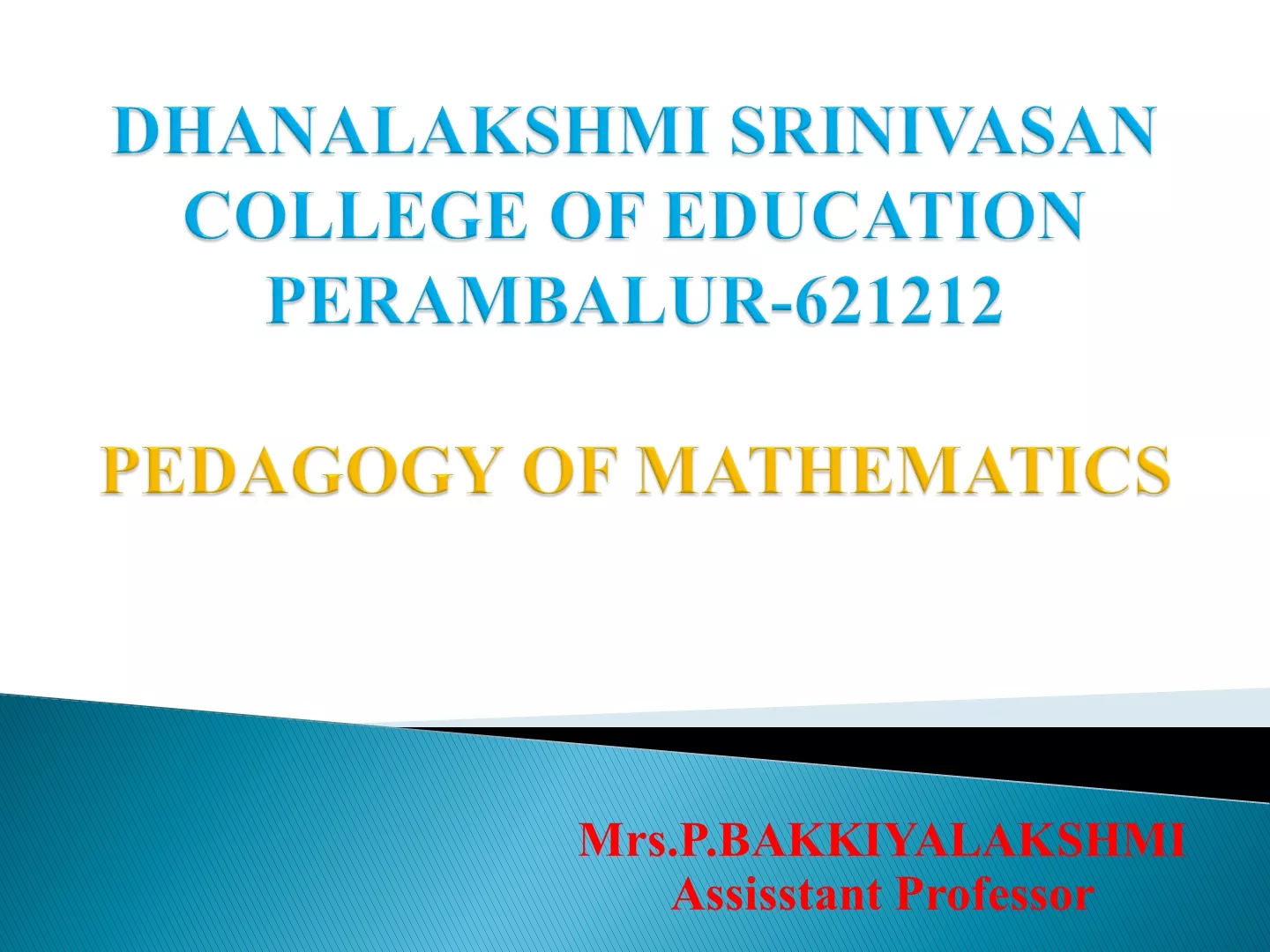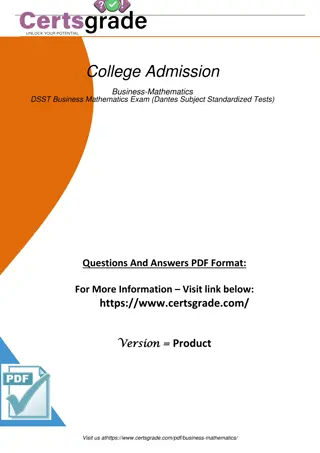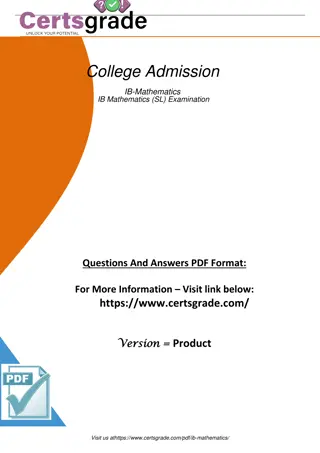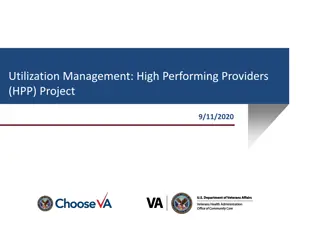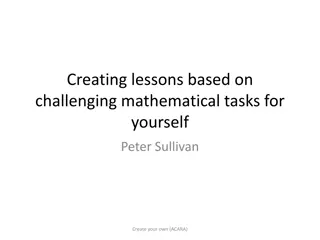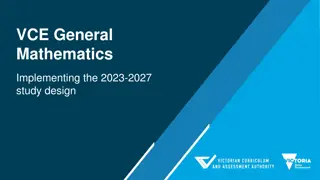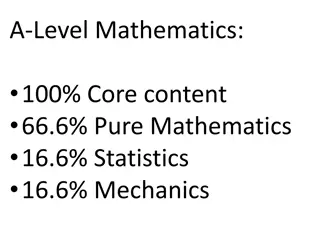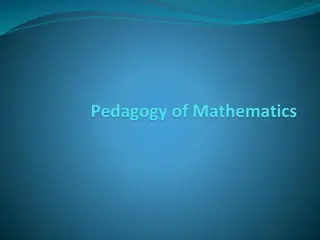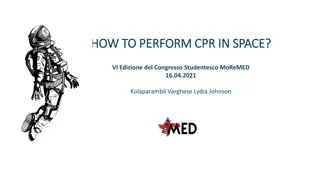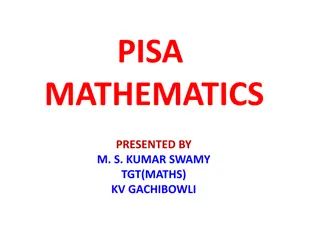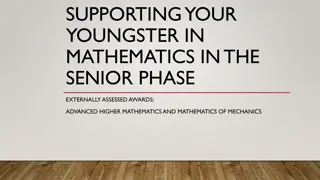Lessons from High Performing Countries in Post-16 Mathematics
This study explores factors influencing participation in upper secondary mathematics, comparing provisions across different routes in various countries. Recommendations emphasize universal access to post-16 math education and compulsory GCSE Mathematics until grade C. Methodology involves literature search, country profiles, and data synthesis, highlighting differences in educational systems and policies.
Download Presentation

Please find below an Image/Link to download the presentation.
The content on the website is provided AS IS for your information and personal use only. It may not be sold, licensed, or shared on other websites without obtaining consent from the author.If you encounter any issues during the download, it is possible that the publisher has removed the file from their server.
You are allowed to download the files provided on this website for personal or commercial use, subject to the condition that they are used lawfully. All files are the property of their respective owners.
The content on the website is provided AS IS for your information and personal use only. It may not be sold, licensed, or shared on other websites without obtaining consent from the author.
E N D
Presentation Transcript
Towards universal participation in post-16 mathematics: lessons from high performing countries Jeremy Hodgen, Rachel Marks & David Pepper, King s College London 15 January 2013
Context Is the UK an outlier? Uniquely low participation rates post-16 The wider agenda ACME: A new advanced level qualification? Wolf: GCSE Previous initiatives FSMQs and AS Use of Mathematics Curriculum 2000
Recommendations All students should be enabled to study post-16 maths at an appropriate level GCSE Mathematics should remain compulsory until grade C achieved One new advanced mathematics pathway aimed at those who have achieved a grade C Encourage a greater breadth in students post-16 programmes
Research Questions What factors drive participation in upper secondary mathematics? What is the content and level of upper secondary mathematics provision and how does it vary across different general and vocational routes?
Methodology 1. Academic literature search 1. Compilation of detailed country profiles Country profiles & national experts 1. Review and synthesis of available data
The Countries Surveyed Hong Kong Singapore New Zealand USA (Massachusetts) Germany (Rhineland-Palatinate) Scotland England
Caveats and limitations Educational systems are culturally very different Upper secondary / Vocational Policy concerns often very different Policy in small systems may be more straightforward Data produced differently and for different purposes
How Far Can We Learn Anything of Practical Value from the Study of Foreign Systems of Education? In studying foreign systems of Education we should not forget that the things outside the schools matter even more than the things inside the schools, and govern and interpret the things inside. Sir Michael Sadler, 1900
How Far Can We Learn Anything of Practical Value from the Study of Foreign Systems of Education? We cannot wander at pleasure among the educational systems of the world, like a child strolling through a garden, and pick off a flower from one bush and some leaves from another, and then expect that if we stick what we have gathered into the soil at home, we shall have a living plant. Sir Michael Sadler, 1900
Participation in upper secondary mathematics education Any Advanced Mathematics Medium Low Medium High High Medium Low Mathematics All All Most Many Many Some Few Hong Kong Germany (R-P) USA (MA) New Zealand Singapore Scotland England
Participation in upper secondary mathematics education Any Advanced Mathematics 22% 8-14% >16% 66% / 40% 39% 27% 13% Mathematics >95% >90% >84% 71% / 44% 66% 48% / 21% 20-26% Hong Kong Germany (R-P) USA (MA) New Zealand Singapore Scotland England
Participation in upper secondary mathematics education Any Advanced Mathematics 22% 8-14% >16% 66% / 40% 39% 27% 13% Mathematics >95% >90% >84% 71% / 44% 66% 48% / 21% 20-26% Hong Kong Germany (R-P) USA (MA) New Zealand Singapore Scotland England
Participation in upper secondary mathematics education Any Advanced Mathematics 22% 8-14% >16% 66% / 40% 39% 27% 13% Mathematics >95% >90% >84% 71% / 44% 66% 48% / 21% 20-26% Hong Kong Germany (R-P) USA (MA) New Zealand Singapore Scotland England
Participation in upper secondary mathematics education Any Advanced Mathematics 22% 8-14% >16% 66% / 40% 39% 27% 13% Mathematics >95% >90% >84% 71% / 44% 66% 48% / 21% 20-26% Hong Kong Germany (R-P) USA (MA) New Zealand Singapore Scotland England
Participation in upper secondary mathematics education Any Advanced Mathematics 22% 8-14% >16% 66% / 40% 39% 27% 13% Mathematics >95% >90% >84% 71% / 44% 66% 48% / 21% 20-26% Hong Kong Germany (R-P) USA (MA) New Zealand Singapore Scotland England
Participation in upper secondary mathematics education Any Advanced Mathematics 22% 8-14% >16% 66% / 40% 39% 27% 13% Mathematics >95% >90% >84% 71% / 44% 66% 48% / 21% 20-26% Hong Kong Germany (R-P) USA (MA) New Zealand Singapore Scotland England
Compulsion? The countries where maths is compulsory have near-universal participation in maths, but not the highest rate of participation in advanced maths New Zealand & Singapore achieve very high participation in maths and the highest levels of participation in advanced maths
New Zealand: Pathways Basic Level 1 Numeracy (and Literacy) required Two different subjects at advanced level Mathematics with calculus / with statistics Mathematics with statistics A distinct and separate subject Small bite-sized units Respected and valued by HE / employers Strong links to the school curriculum
Singapore: Breadth Academic / pre-university system A-level(reformed to give more local control) Contrasting subject required in the academic / pre-university route Flexibility and choice through polytechnics / vocational routes An extended duration O-level course is available BUT reduction in Further Maths
Hong Kong: A cautionary tale? Reform of the entire secondary / tertiary educational system HKDSE to replace A-levels Upper secondary education to 17 not 18 Mathematics compulsory (but not only mathematics) BUT advanced mathematics participation fallen slightly Not required by all numerate HE courses
Breadth, pathways and choice Compulsion is not sufficient Encourage breadth Provide appropriate and valued pathways Mathematics is never the only compulsory subject
Factors and incentives Attainment more important than attitudes & aspirations Information, advice and guidance poorly understood
Factors and incentives Attainment more important than attitudes & aspirations Information, advice and guidance poorly understood BUT The strongest incentive for students to study advanced mathematics is that they are required to do so to progress to higher education and employment
Policy What can be learned from smaller, successful systems? Success of a qualification depends on a range of factors Wide availability Respected by and required by HE / Employers Valued by schools / colleges Relatively long timescales for implementation
Risks Teacher supply The FSMQ problem Availability and take-up Respect and value by HE / Employers Vocational routes Dangers of stratification
Recommendations: What All students should be enabled to study post-16 maths at an appropriate level GCSE Mathematics should remain compulsory until grade C achieved One new advanced mathematics pathway aimed at those who have achieved a grade C Encourage a greater breadth in students post-16 programmes
Recommendations: How Encourage breadth of study Any new qualification / pathway needs to be attractive to and valued by: Students Schools / Colleges HE / Employers Enable HE / employers to require maths Implement over an extended time period Research: teacher supply, IAG, vocational
